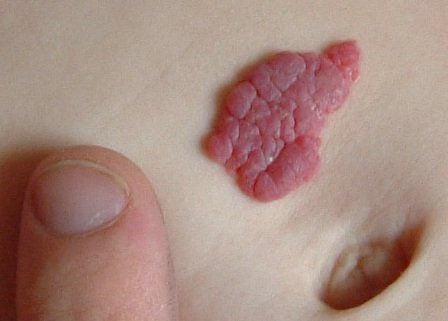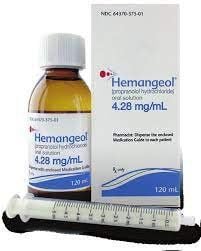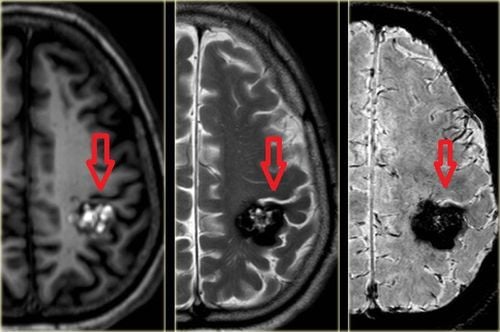This is an automatically translated article.
The article was professionally consulted by Specialist Doctor I Tran Van Sang - Dermatologist - Department of Medical Examination & Internal Medicine - Vinmec Danang International General Hospital. The doctor has 18 years of experience in the field of Dermatology.Hemangiomas in children are usually benign, disappearing on their own before the child is 10 years old. However, there are also some cases where hemangiomas continue to grow, invade other organs or have complications, greatly affecting the health of children.
1. What is hemangioma?
Hemangiomas are benign tumors that are common in young children. Approximately 30% of hemangioma patients are infants in the first month of life. The majority of hemangiomas appear in children at the age of 1 year, a small part occurs in adults.Hemangiomas are formed by the proliferation of blood vessels (arteries, veins and capillaries). There are three main types of hemangiomas: hemangiomas, cavernous tumors, and mixed tumors. Hemangiomas can appear anywhere on the body, but statistics show that 60% of cases have hemangiomas on the skin, located in the head, face, and neck. A subcutaneous hemangioma is located deep below and covers the skin. Only a small percentage of hemangiomas appear in internal organs, usually the liver or in the spine.

2. Signs of hemangioma
Hemangioma is a common skin disease, so the signs are quite clear. They manifest in 3 levels:Mild: There are color changes on the skin, usually red, purple red or bluish. At this stage, they rarely form tumors, but are flat like birthmarks in babies; Moderate grade: Hemangioma develops into a true tumor, raised or raised the skin into a mass of clear shape and size. They remained the same color - the color of the blood in the tumor; Severe grade: Same as moderate but with accompanying symptoms when the tumor ruptures or becomes complicated. If the tumor is outside, it will bleed, if the tumor is deep in the body, it will break open and ulcerate. In addition, the patient also has specific signs in the organs with blood tumors when the tumor enlarges and presses on the internal organs.
3. Is hemangioma in children dangerous?
Hemangioma is characterized by a very benign tumor, most of which shrinks on its own as the child grows up and heals on its own, in rare cases the tumor persists and grows large. Besides, hemangiomas are often located outside the skin, so it is easy to detect the disease, helping doctors have a plan to monitor and treat timely and effectively for patients. However, there are also some cases of hemangiomas that do not shrink on their own but cause complications.
Hemangiomas located in the oropharynx can cause breathing difficulties when they grow too large, sometimes children have symptoms of painful swallowing if the tumor is superinfected. Pediatric patients with oropharyngeal hemangiomas also have prolonged hoarseness and cough; Hemangiomas in the larynx can cause the patient to cough up a lot of blood and be difficult to control due to the deep location of the tumor. These cases often require partial or total laryngectomy to remove all lesions and avoid recurrence; Hemangiomas in the heart can reduce circulation through the heart due to the hemangioma taking up place, which over time can lead to heart failure; Hemangiomas in the spine easily weaken bones; Hemangiomas in the liver can obstruct some of the bile ducts; Hemangiomas in the eye can cause vision impairment; Hemangiomas in the ear easily cause hearing loss; Hemangiomas can be complicated by ulceration, bleeding or infection, tumor necrosis; Angiomas lead to Port-wine stains - wine-colored stains. The birthmark is pink, burgundy, or reddish, flat, and varies in size, and usually appears on the face, neck, arms, or legs. If birthmarks appear on the forehead, eyelids or sides of the face, it can lead to glaucoma, which, if left untreated, can lead to blindness. Newborns with this type of birthmark should have their eyes and brain tested; Hemangiomas lead to Sturge Weber's syndrome - characterized by vascular malformations in the skin combined with vascular abnormalities in the eye area. 5 - 8% of cases with Portwine stains have a risk of Sturge Weber syndrome. Symptoms of the disease are epilepsy, hemiplegia, cataracts and neurodevelopmental retardation (found in 55-92% of cases); Hemangiomas growing on the genitals, rectum, ... can affect the reproductive health of the patient; Hemangiomas cause skin dilation or scarring, affecting the patient's appearance and psychology. Although hemangiomas are benign, they still have a small percentage that can lead to many unpredictable complications. Therefore, early detection and diagnosis of hemangiomas are essential to preserve organ function and provide the best quality of life for patients. If a child has a hemangioma or dark birthmarks on the skin, parents should take the child to the hospital soon for examination, diagnosis, and timely and effective treatment.
Please dial HOTLINE for more information or register for an appointment HERE. Download MyVinmec app to make appointments faster and to manage your bookings easily.














